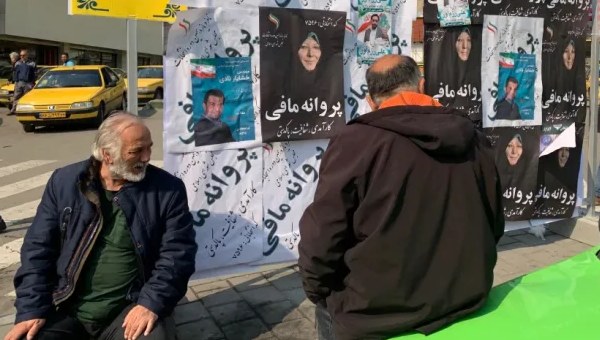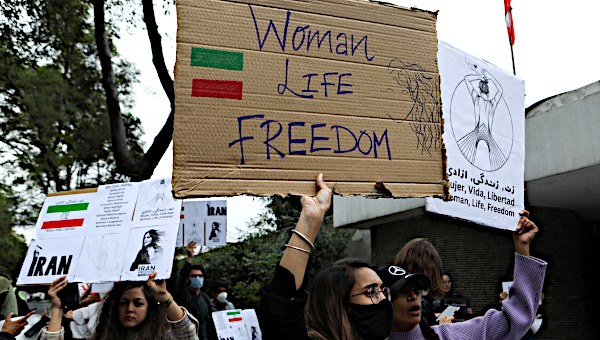Protests in Iran: Not Just About Stolen Votes
Since the June 12 elections declaring incumbent President Mahmoud Ahmadinejad the winner, large scale violence not seen for a decade has erupted in cities throughout Iran. Running against former Prime Minister and opposition candidate Mir Hussein Musavi, news of Ahmadinejad’s election victory from the Interior Ministry came less than an hour of the closing of the polls with astonishing statistics. With the massive turnout of around 85% of Iran’s 46 million eligible voters, Iranian election officials credited Ahmadinejad with a 62.6% victory, and announced Musavi’s defeat with a mere 33.8% of the total votes cast. In response to the outrageous figures, the opposition leader has since Friday night been accusing both Ahmadinejad and the Interior Ministry of having cheated in the election and voting process.
Calling the election results a “dangerous charade,” Musavi also submitted an official formal request to the Guardian Council on June 14 to protest against the results. While victory for Ahmadinejad was not ruled out throughout the election, the overwhelming margin of almost 30% between the two major candidates prompted widespread suspicion and uproar among Iranians, asserting that both the voting and counting process were manipulated by the conservative Iranian government. While initially issuing a categorical rejection of the claims of the opposition leader and ordering the defeated candidates and their supporters to avoid “provocative” behaviour, Iran’s supreme leader Ayatollah Ali Khamenei announced on June 15 that he had ordered an investigation into accusations of vote-rigging and manipulation that had given Ahmadinejad a landslide victory.
Signs of a Stolen Election
Crafting a populist role, Ahmadinejad went on long travels through Iran’s provinces during the weeks leading up to the elections to display himself as an “accessible” leader. Adopting the guise of an enemy of elites and corruption, Ahmadinejad also promised to improve Iran’s battered economy and devote more resources to projects in poorer provinces. A more youth-driven movement was launched by Musavi’s “green” campaign, which ran on demands for a more stable economy, increased social freedoms, and improved relations abroad. The two other major candidates are Mehdi Karroubi, the only cleric in the race who, while criticizing the ruling establishment, is also known for his parliamentary battles against reformists, and Mohsen Rezaei, the current secretary of the Expediency Council who served as commander of the Iranian Revolutionary Guard from 1981-1997.
Popular allegations of ballot fraud in the elections are based on a number of inconsistencies and signs of irregularities around the results.
Unlikely support bases: Election officials claim Ahmadinejad won the city of Tabriz with 57% of the vote. This is seen as unlikely as the opposition leader Musavi is from Iran’s Azerbaijan province, of which Tabriz is the capital, and had large well-attended rallies there prior to the election. Further, given that in the past Azeri voters have expressed disproportionate support for minor presidential candidates who were actually from the province, it is unlikely that Ahmadinejad would receive such heavy electoral support.
Implausible numbers: The official votes for Karroubi are around 320,000, placing him after Rezaie who – despite polling indications of extremely low popularity – allegedly received twice as many votes as Karroubi. His supporters are challenging the results, pointing to Karroubi’s 17% voter support in the first round of the 2005 presidential elections, and the projected increase in the June 12 elections given Karroubi’s increased public engagement and support.
Unbelievable speed of ballot count: While Iranian elections are notoriously unpredictable and it is entirely possible that Iranians in other areas of major cities could have voted for Ahmadinejad, the speed of the ballot count along with the alleged high voter turnout bring the results into question. Election officials declared Ahmadinejad’s victory barely an hour after the closing of the polling stations drawing widespread suspicion of government interference.
The above allegations along with claims of misplaced votes, manipulated ballots with missing national identification numbers rendering them invalid, leaked claims from unnamed interior ministry sources that false numbers were fed into the electoral software program, and statements by election officials announcing the results were prepared before the count on election night, all contribute to popular calls for an investigation.
Voices on the Iranian Streets
Since the announcement of the election results, violent clashes between state police and demonstrators protesting alleged fraud in the elections have occurred in several parts of the capital Tehran, and in cities around the country including Tabriz, Shiraz, Orumieh, Hamedan, and Rasht. It is also important to mention that pro-Ahmadinejad protests are also taking place in large numbers in response to widespread allegations of election fraud, and these too have gained some momentum.
With the start of the mass demonstrations by opposition supporters, Iranian state police began arresting over 100 reformist figures and blocked public access to a host of online social networking sites such as Facebook, Friend Feed, Twitter, and YouTube, along with news sites, and cellphone and SMS service in parts of Iran. However, despite state attempts to limit the transfer of information and block communication channels, Iranians are finding alternative ways of organizing demonstrations online.
Video footage and pictures distributed online reveal the intensity of the clashes during the demonstrations, with riot police and undercover government vigilantes using tear gas, driving motorcycles and sporadically shooting into the protesting crowds which consist of mostly urban Iranians and students. Hundreds of cases of stabbings and immense beatings are reported which, in addition to countless injuries, have resulted in a number of deaths in Tehran alone so far, but rumoured to be over 100 in the country as a whole. For regularly updated video footage and pictures, visit here.
After intense street protests on June 14, government-sponsored paramilitary vigilantes entered Tehran University in the late hours attacking students in their dormitories. Through independent sources it is estimated that 3 were killed, over 80 students arrested, and many others heavily beaten and suffering from broken bones. Despite these violent attacks against the unarmed students, more than one million Iranians participated in a demonstration in Tehran’s Azadi Square on June 15, defying an official ban on a rally in the city’s centre area. Independent accounts of sporadic shots fired at the crowds from a compound for pro-government forces left several seriously wounded, with reports that 4 protesters have allegedly been killed as a result. Given his absence from the public eye since the announcing of the election results, rumours of Mousavi’s house arrest subsided after he and other reformists made an appearance at this rally. (For pictures of the June 15 rally, visit here.)
The sophistication of the voices on the Iranian streets are revealed in the chants and tactics of the opposition protesters. Refraining from direct mentioning of corrupt leaders, the demonstrators refer to “the dictator,” “the liars,” and “the thieves” to condemn the election results, actions of government officials, and the continued brutality of the Iranian state. In Tehran, protesters chant “we don’t want a coup d’etat government” (dolat-e coup d’etai, nemikhaim, nemikhaim) and “by the end of the week, Ahmadi is gone” (akhare hafte, Ahmadi rafte) to express their allegations of election fraud. But they are also chanting “down with the dictator” (marg bar dictator) and “end to Taliban, whether in Kabul or Tehran” (marg bar Taleban, che Kabul, che Tehran) to criticize state violence and continued infringements to the social and political rights of Iranians.
Independent footage from protesters also show cases where pro-government forces on motorcycles attack the marching crowds who, after being violently dispersed and beaten with batons, re-organize and charge the mobile police to reclaim the streets. After capturing and disarming the officers and setting fire to their motorcycles as a symbol of resistance against state violence, some of the protesters move the officers away from the justifiably angry crowds in an apparent attempt to protect them from harm, and maintain the moral and politically peaceful nature of the opposition movement and the demonstrations. Further, seeking to assert the reformist nature of the protests and gain supporters in the state police, it is reported that protesters were instructed by opposition websites to bring flowers in the coming days followed by the chant “brothers in the armed forces, why do you kill your brothers?” (baradare arteshi, chera baradar koshi?).
All in all, the above chants and methods of organizing reveal that the diverse and massive public protests in Iran, while prompted by allegations of election fraud, are fuelled and shaped around popular demands condemning the violence of the regime.
Standing in Solidarity with the Struggle of the Iranian People
Individuals and groups in solidarity with the Iranian people should take note of the historical and political context of these protests. The socio-political problems facing the Iranian people will not be quelled with the declared election victory of either Ahmadinejad or Musavi. On the domestic front, both candidates have records of human rights abuses in their personal and political careers, both are extensions of the political establishment in Iran, and neither is calling for fundamental changes within the Iranian state.
As for international relations, both are willing to engage with the new American administration so long as the meeting is held without preconditions. And no doubt, President Obama will sit with either candidate (and Europe will follow suit) given the realization that stability in the Middle East is predicated upon Iranian participation. Granted, demonstrators are calling for an investigation into the election results with the contention that Musavi is the victor. But their chants, placards, writings, and their personal risks in demonstrating indicate that they are also calling for relaxed social laws, political freedoms and an end to the brutality of the Islamic regime.
As important is the realization that these protests are not a call for foreign intervention. Nor are they a call for increased economic and political strangulation of the Iranian state and people. Attempts, for example, by Canadian MPs to pressure and alienate Iran through parliamentary bills such as the Iran Accountability Act, which promote divestment from Iran to hold it accountable for its human rights violations, are counter-productive. They instead increase state pressure on voices in Iran calling for social and political freedoms. Such policies fail to recognize that the problems in Iran can only have a domestic solution, without interference from the imperialist powers, and that the Iranian people are the ones who can and must hold the regime accountable for its many violations.
Whether this is a revolutionary movement – and of what kind – is hotly debated, particularly among Iranians. The scenes and chants remind many activists of the political atmosphere in Iran in the late 1970s. However, the limited potential of these demonstrations in overthrowing the Islamic regime is well known to both protesters and the keen observer, given the state’s unequal access to arms and resources. That said, lessons from the last revolution forces the realization that we simply do not know where these protests will lead. Those truly in solidarity with the Iranian people must maintain a sober analysis regarding the demands of this movement, awareness of the machinations of imperial and regional powers, and pay attention to the political direction of its participants. •





